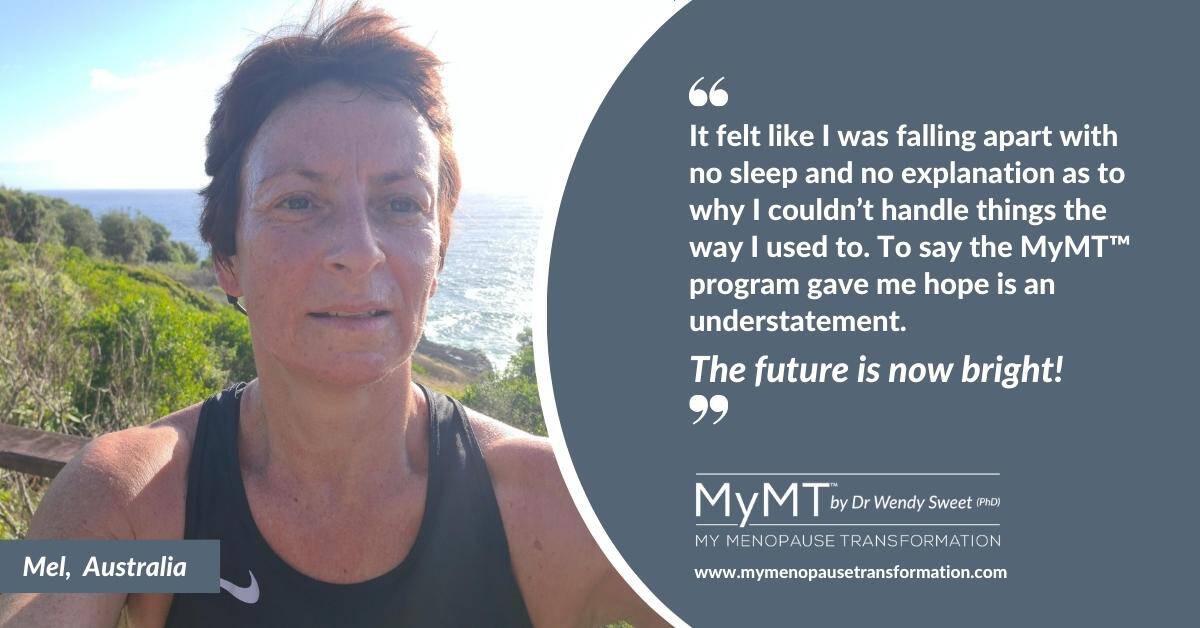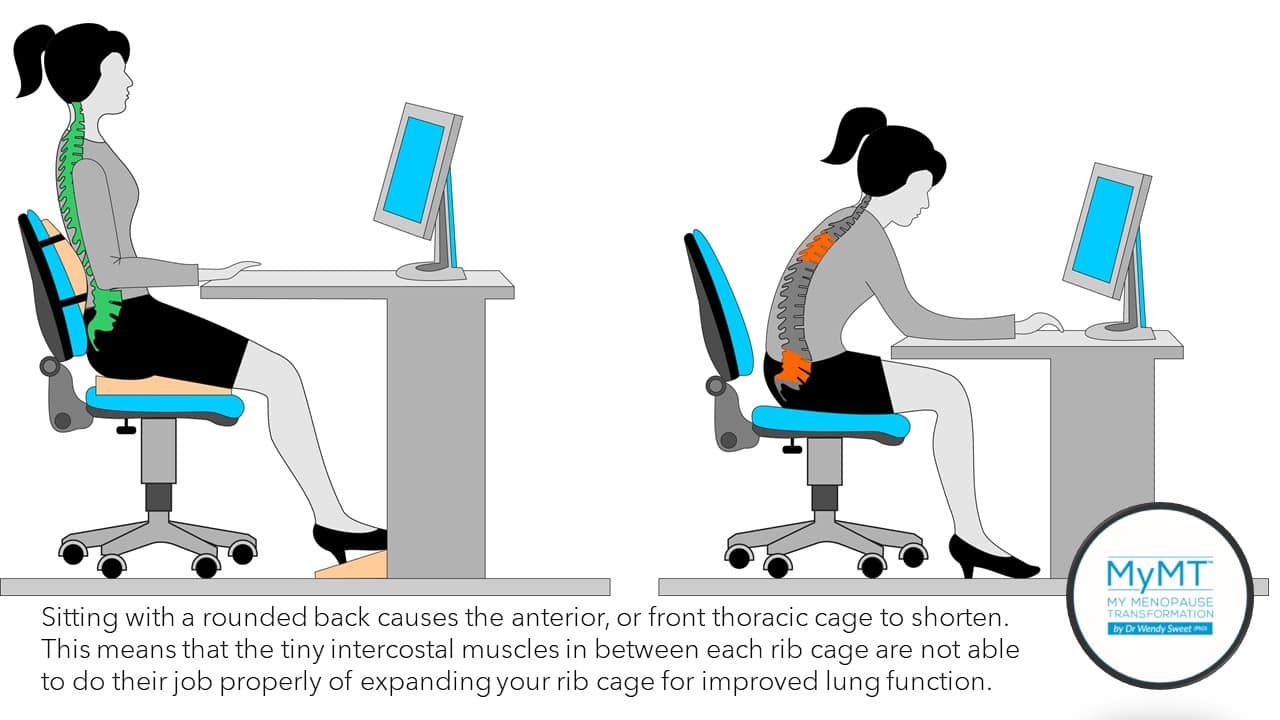My hike up a steep hill last weekend was the start of my ‘summer’ fitness plan. As snow usually covers this hiking trail, I have to wait until this time of year to grab my hiking poles and leave the winter behind. It’s time to work on my post-menopause fitness, especially my cardio-pulmonary (heart-lung) fitness.
At times the steepness of the path caused me to to think my heart rate had reached it’s peak capacity. I stopped and took it at one stage, but it was fine – what I was struggling with was the depth of my breathing – and I knew why.
Declining oestrogen as we move through menopause causes us to lose some lung capacity – in fact, up to a litre of precious lung capacity is lost as we move into post-menopause. If you find that you are more breathless when you climb the stairs or do your usual exercise, then this could be why. These lung changes in peri-menopause and again in post-menopause also contribute to your feelings of anxiety.
So, as a timely reminder, I want you to stop what you are doing, and take a few slow breaths through your nose. When you do this, you will be helping your lungs to expand and fill more deeply. If you’re in menopause then rest assured, this is an essential part of your self-care for your health – as oestrogen production declines, menopause is associated with accelerated lung function decline [Triebner, Matulonga, Jahannessen et al., 2016].

A number of studies report that lung function declines more rapidly among women who are transitioning through menopause and into post-menopause – in particular, the most important changes occur to our Forced Vital Capacity [FVC].
This refers to the total amount of air exhaled in one breathe. I think many of us have felt this change as we’ve aged. I know that I used to feel that I couldn’t quite catch my breath when I was swimming or jogging. And it’s not only when we are exercising, but also when we are resting. As Diane mentioned,
“I didn’t sleep well last night. It seemed as if I struggled to breathe and I could feel my heart racing as well. The Doctor can’t find anything wrong and I feel exhausted. I know it’s something to do with menopause?” [Diane, United Kingdom].
The email from Diane felt like deja vu. I used to lie in bed and feel that my breathing was more shallow too. Whilst increased anxiety can cause our breathing to change when we arrive in menopause, I personally felt that I wasn’t able to breathe in deeply enough to fill my lungs. I also felt I had more phlegm building up overnight.
Who knew that our lungs are affected by lowering oestrogen too? I certainly didn’t.

Many of us never give our lung function a thought as we move through menopause, but for those of you who sit at a desk all day, then it’s important for you to be aware of your changing lung capacity.
For decades I’ve been a regular exerciser and one of the known benefits of regular exercise is that it stimulates our breathing. But when I began to experience more breathlessness in my early 50’s, especially during all the high intensity exercise that is promoted to us, I began to get more curious about my lung function and the connection to menopause.
One of the very first studies to investigate the effect of menopause on lung function in a large population-based survey was undertaken by researchers with support from the Norwegian Research Council.
It’s known as the European Community Respiratory Health Survey and has been going on for a number of years and has only recently followed up with women transitioning through menopause. I’d like to thank them for including nearly 2000 menopausal women and testing them. Because as you can see from the graph above, our lung function declines as we age.
Part of this decline in lung function is also the reason for women feeling that their anxiety levels are changing as they move into peri-menopause too. If we can’t get enough oxygen around our body to deliver to cells and tissues, then there is going to be consequences of this – including an elevated heart rate and feelings that we aren’t coping.

As we move through menopause, our body is changing. As such, there are changes that we have to adjust to. One of the strategies that I teach women on my 12 week programmes, is to improve their breathing and lung function.
Researchers have discovered that the lungs play a far more complex role in mammalian bodies than previously thought, especially in middle-age females.
It seems that our lovely lungs don’t just facilitate respiration – they also play a key role in red blood cell production and platelet function, along with bone marrow. These areas contain oestrogen receptors too.
This means that as we get older, lung function declines. As such, we have to purposefully focus on regulating our breathing every day and engaging in activities that stimulate our lung function to try to reduce the rate of decline.
Lung function and capacity reduces as we move into menopause.

But there are other causes for poor lung function in mid-life too – poor posture from sitting or standing, as well as belly-fat that sits under the diaphragm.
Many women work in sedentary jobs, hence lung function may also change when we sit hunched over computers or we are sitting at desks throughout our day. If we also have the dreaded fat-roll under the diaphragm as I used to, then this impacts on our breathing too.
Sitting all day prevents your lungs from performing to their best. When we sit, our back is rounded, and the anterior, or front thoracic cage shortens and becomes a bit squashed. This means that the tiny intercostal muscles in between each rib cage are not able to do their job properly.
These smaller rib-cage muscles lose oestrogen too, so as we transition through menopause, they don’t function as well as they used to in expanding our rib cage and lungs with each breath. Over time, this can contribute to loss of lung capacity and cardio-respiratory fitness.
If this is you, then can you focus on standing up every hour, pulling your tummy muscles in tight and lifting your arms above your head and really getting some function in those ageing lungs of yours?

Lung Function and Weight Loss
The role of the lungs and how they contribute to our circulation, tissue oxygenation, energy levels and our weight management is more powerful than previously thought.
When I was trying to lose my menopause belly fat, I began to focus on the physiology that I had taught students for years, and that is that when it comes to tissue oxygenation and fat-loss, our breathing matters.
Fat is ‘burned’ in our lovely mitochondrial cells and this is where oxygen is stored. Having an efficient respiratory system is fundamental to moving oxygen in and out of our mitochondrial cells. Your breathing, stretching and cardio-respiratory fitness is as important as it ever was as we go through menopause..
That’s why when we focus on our breathing, we also improve fat loss. For women with lots of belly fat and diaphragmatic fat, lung expansion can be reduced up to 40%, because of the location of our fat gain in menopause.
Improved breathing helps oxygen to move into our mitochondrial cells. These cells store oxygen. Located deep inside our muscles, lungs and heart, mitochondrial cells are the ‘power-house’ of your cell because not only is oxygen stored in these cells, but this is the location of energy production from fats and glucose.
When we improve our breathing, then we help to move more oxygen into mitochondrial cells and this means that fat-burning mechanisms are improved too.

We all know that our rib cage protects our lungs, but did you know that between every rib are small muscles, called intercostal muscles? These muscles are also affected by our loss of oestrogen as we age and like other muscles, they lose their elasticity. This makes them less effective, so they need to be stimulated and exercised.
Some of you might even like to do the stretches below. The one over a swiss ball if you attend a gym or have an exercise ball like this at home, is powerful. You can even just do this stretch over a rolled-up towel lying across your upper-back whilst you are on the floor or if you can’t get on the floor, lie on your bed over your pillow.
If you are hunched over a desk all day or you are in a job that requires you to hunch over a lot, (e.g. housekeeping or nursing) then your intercostal muscle fibres become lengthened at the back of your rib cage and shortened at the front. Over the course of the day, your lung capacity and function might be impaired.

If you are mainly sedentary in your working week, then it would be great if you made a plan to do some aerobic, steady-state exercise in the weekends and focus on your breathing. Breathing better is something that we all need to do more of. As the world starts to open up, there’s’ never been a better time to focus on our respiratory health.
If exercise and your cardio-respiratory fitness is a struggle and you want to get your fitness back now that you are in your 50s, but don’t know where to start, then when you have time, have a listen to the video below.
It’s about the Rebuild My Fitness 12 week online programme, which is also available for you, either alongside the Transform Me or Circuit Breaker programmes if you have symptoms and/or you are overweight, or purchase the exercise programme on it’s own.
I would love to share with you my 30 years of knowledge and experience as a REPS NZ Exercise Specialist, as you improve your fitness, strength, balance and flexibility during or after menopause.
You can do it online in the comfort of your home, so no gym visits if you don’t want to [although there are programmes you can download to take to the gym as well].
Part-payments for 3 months are available too. Please use the promo code MYMT2023 if you purchase any of the 12 week programmes to get your NZ$75 discount. And yes, you learn all those important breathing exercises too. I invite you to listen to the video about my exercise programme below.
References:
Memoalia J, Anjum B, Singh N, Gupta M. Decline in Pulmonary Function Tests after Menopause. J Menopausal Med. 2018 Apr;24(1):34-40. doi: 10.6118/jmm.2018.24.1.34. Epub 2018 Apr 30.
Sharma, G. & Goodwin, J. (2006). Effect of aging on respiratory system physiology and immunology. Clinical Interventions in Aging, 1(3) 253–260
Triebner, K., Matulonga, B. Johannessen, A. et al., (2016). Menopause is associated with accelerated lung function decline. American J. of Respiratory and Critical Care Medicine, Vol 195(8), pp. 1058-1065.

